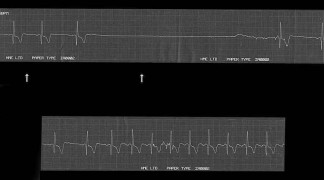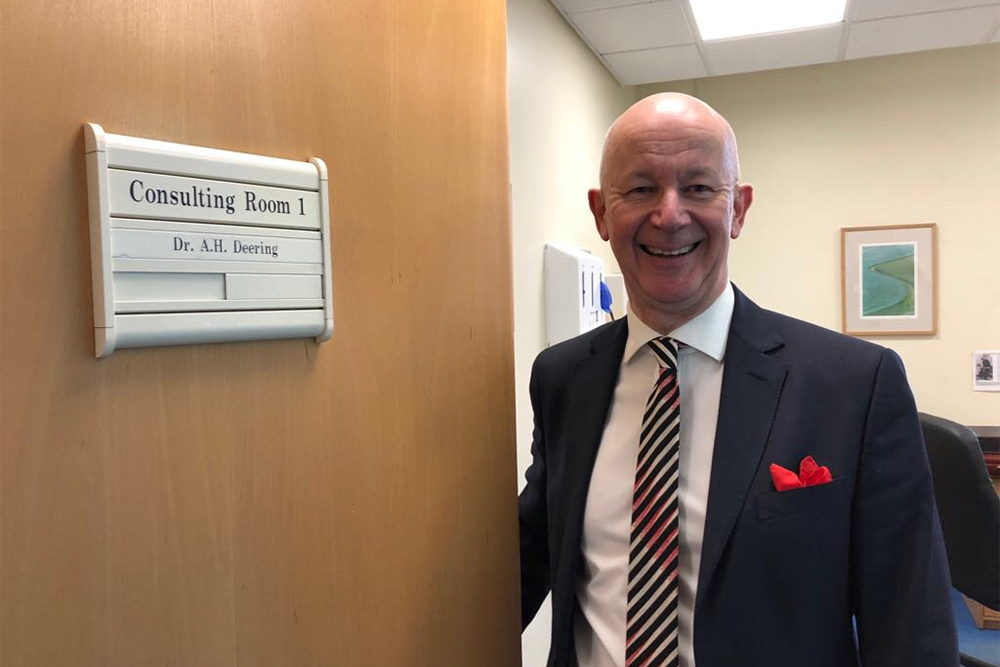In this condition dizziness, presyncope or syncope may be precipitated by any manoeuvre which causes mechanical stimulation of the carotid sinus – such as turning the head, looking up, or wearing tight collars.
The carotid sinus is a dilated portion of one of the major arteries supplying blood to the head. The sinus has nerve endings and acts as a pressure detector feeding back information to the vasomotor centre – an area in the brain stem that controls blood pressure and heart rate.
Carotid sinus hypersensitivity is diagnosed when carotid sinus massage causes a three second, or longer, pause in the heart beat (cardioinhibition) – see ECG traces below – or lowering of the blood pressure by 50 mm Hg. or more (vasodepression). 56% of cases of unexplained syncope are found to have Carotid sinus hypersensitivity.
Carotid Sinus Syndrome is diagnosed when typical presyncopal or syncopal symptoms accompany carotid sinus massage. 26% of cases of unexplained syncope are found to have Carotid Sinus Syndrome.
In this condition dizziness, presyncope or syncope may be precipitated by any manoeuvre which causes mechanical stimulation of the carotid sinus – such as turning the head, looking up, or wearing tight collars.
Carotid Sinus Syndrome is rare under 50 years age.
Cardioinhibitory carotid sinus syndrome is more common, and easier to treat, than the vasodepressor type.
Interestingly, 80% of fallers found to have carotid sinus syndrome are amnesic for witnessed associated loss of consciousness. The individual will simply report a fall – an important point in history taking.
Prodromal symptoms are more common with vasodepressor carotid sinus syndrome, making it easier to take appropriate action.
Carotid sinus massage is carried out in a quiet warm room. ECG and blood pressure monitoring equipment is attached and, after a brief period of rest, gentle pressure is applied to the right carotid sinus for five seconds with continuous monitoring of heart rate and blood pressure. If no response, or physiological responses only, are obtained, massage is performed once the heart rate and blood pressure have returned to baseline – this usually takes about 30 seconds. The left carotid sinus is then tested. Massage should then be repeated when tilted at 70 °.
Because there is a small risk of inducing neurological complications (with an incidence of 0.4% for transient symptoms and < 0.02% for permanent neurology) carotid sinus massage should not be carried out if there is a history of recent cerebral ischaemia or if there is a carotid bruit unless investigation has demonstrated normal flow characteristics. Other contraindications include recent myocardial infarction and previous ventricular tachydysrhythmia. Some medications, including Digoxin, Diltiazem, Beta-blockers and Alpha Methyldopa, increase carotid sinus sensitivity. If carotid sinus massage elicits a positive response when a patient is taking one of these medications, the medication should, if possible, be discontinued and carotid sinus massage repeated at another time.

This ECG trace shows 10 seconds of ventricular standstill following carotid sinus massage. The two arrows show the period of massage. Typical symptoms were reproduced.
Implantation of a permanent pacemaker abolished this patient’s collapses.
The mechanism for carotid sinus hypersensitivity is unclear.
Research suggests that the problem may lie within the sternomastoid muscle. This muscle overlies the carotid sinus. In normal individuals simultaneous pressure of the sternomastoid muscle and the carotid sinus caused by turning the head for example – is correctly interpreted by the brain as external pressure, and is therefore ignored. If, however, there are defective impulses from stretch receptors in the sternomastoid muscle the changes may be interpreted as a rise in intraluminal carotid sinus pressure warranting action.
Drugs known to enhance carotid sinus sensitivity – Digoxin, Diltiazem, beta-blockers and Alpha Methyldopa – should be stopped.
Dual chamber pacing, using a very sophisticated pacemaker, abolishes cardioinhibition (slowing of the heart), but has no effect on the vasodepressor (blood pressure lowering) component of carotid sinus syndrome.
Luckily cardioinhibitory Carotid Sinus Syndrome is more common than the vasodepressor type. Pacemakers can render patients symptom free, or almost symptom free.
No effective treatment for vasodepressor Carotid Sinus Syndrome is known but it is worth trying Fludrocortisone or other measures used to treat orthostatic hypotension.


